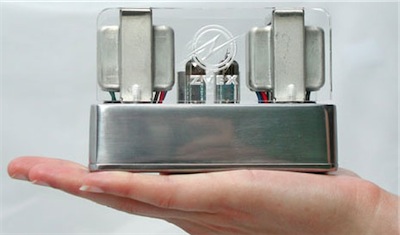Audiophiles and the limitations of human hearing October 13, 2007
Posted by Johan in Applied, Sensation and Perception, Social Psychology.trackback

The other week Gizmodo posted an amusing rant about a set of $7250 speaker cables, and the gushing review they received. Among other things, the reviewer referred to the cables as “danceable.” James Randi soon popped around to offer his $1 million prize to the cable company, if they could prove that their cables outperform “normal” Monster cables in a double-blind test.
This is actually an issue of the limits of human perception. Is it really possible to tell the difference between normal high-end equipment, and equipment that veers into the audiophile range? It’s clear that according to many audiophiles, the answer is going to be yes. Wikipedia informs us that there are actually two schools among audio enthusiasts: the objectivist school, which favours double-blind testing, and subjectivists, who favour a more philosophical approach. The review that caused so much ire comes from Positive Feedback, an online magazine that concerns itself with the “audio arts” – guess which school they subscribe to.
Among subjectivist audiophiles, there is a belief that almost any change to the stereo setup results in a perceptible difference in sound. This results in bizarre behaviours, as in this picture from the Positive Feedback staff page:

Note how the speaker cables are carefully propped up on stilts to keep them off the floor, and how what looks like power amplifiers are propped up on massive slabs of wood (I can assure you those didn’t come from the local lumberyard). Another nice example comes from an article in Hi-Fi magazine Masters on Video and Audio:
“The [product] tightened up the sounds of a wide variety of equipment, the improvements often most noticeable in the bass. Imaging and focus usually improved, as did the interstitial quiet, which raised the level of overall palpability, air, and transparency.”
The product? Shelves.
There is one obvious objection to raise here: judging by the pictures of the reviewers on sites such as Positive Feedback, most of them are in their 40’s and beyond. As the following figure shows, this spells trouble:

I grabbed this from a lecture handout, so unfortunately I don’t know the source. The lines plot performance at detecting sounds over age, with each line representing a frequency. In this case “hearing level” is a standardised measure where normal hearing is at 0 dB. The clear pattern is that the higher frequencies disappear with age. This figure only goes up to 6 khz, but it’s worth noting that the human ear can hear up to 20 khz, and that the loss is more dramatic the higher up you go.
In other words, it’s not really worth trusting an audio reviewer who is older than you are, because there is a range of higher frequencies that you can hear while they cannot.
Apart from the overall lack of evidence and the sheer physical implausibility of some of the products, there is some classic research in social psychology that have implications for this topic.
Cognitive dissonance theory was primarily developed by Festinger. Briefly, the idea is that when the individual finds himself in a state where internal beliefs conflict with reality, there is dissonance, which is an unpleasant state. The individual may then employ a number of mechanisms to get around the dissonance, ranging from simply acknowledging that the beliefs were wrong to attacking the reality of external events, or devaluing the conflict.
The classic cognitive dissonance study is one where students perform a dull experiment, and are then paid a small or a large amount of money for telling the next participant that the experiment is actually fun (Festinger & Carlsmith, 1959). Surprisingly, students who are paid less actually rate the dull task as more interesting. In this case, the student finds himself (all males in Psychology studies in those days, generally) in a conflict: he has just done a boring experiment and lied to a fellow student for a very small reward. According to Festinger and Carlsmith, the student then reduces dissonance by re-evaluating the task. If the task was actually fun, then there is no dissonance between the student’s actions and beliefs.
The implication for consumer behaviour is that when your green $7250 cables arrive in the mail and you plug them in, finding that they do nothing would result in unacceptable dissonance. In fact, cognitive dissonance theory predicts that the more you pay for the cables, the more inclined you will be to conclude that they sound good, regardless of the actual quality of the cables. In this context, it is worth noting that the Positive Feedback website states that their policy is that reviewers should own the equipment they review, which is a very unusual policy in light of cognitive dissonance theory.
There is another classic social psychology study that is relevant here: Sherif’s investigation of the autokinetic effect (1935). To observe this effect, place yourself in an absolutely dark room with a single, faint light source. The spot of light will appear to move around as a result of small eye movements that your brain normally filters out. Sherif’s participants didn’t know about this however, so they really thought the light moved.
When the participants rated when the light moved individually, there was considerable variation between the participants in how far the light moved. Sherif then placed participants in groups and asked them to call out the movements of the light. Now, there was a convergence effect, so that the estimates of the different participants came closer to each other, and remained close in subsequent individual re-tests.
If you and your friend are listening to a new stereo and she mentions that the low bass sounds a bit flat, you are going to hear it too. The sound itself is ambiguous, not to mention the terminology that audiophiles use, so Sherif’s study suggests that in such situations, you will align with the group. You can imagine that this tendency to conform is quite useful in many real-life contexts, but it does mean that wine sampling and stereo testing are unlikely to reflect anything other than your tendency toward conformity. That doesn’t mean it can’t be fun, of course.
You can test this out yourself if you ever find yourself at a wine sampling. Make up associations: say the wine tastes like blackcurrant (always a a winner), sandal wood, tobacco, myrrh. As long as your ideas aren’t too far off, you will find that others suddenly experience the taste too.
While our senses are rather limited, our ability to fool ourselves is almost endless.
References
Festinger, L., and Carlsmith, J.M. (1959). Cognitive Consequences of Forced Compliance. Journal of Abnormal and Social Psychology, 58, 203-210.
Sherif, M. (1935). A study of some social factors in perception. Archives of Psychology, 27.
[…] a continuation of the recent post on audiophiles, let’s look closer at how good we are detecting the compression in digital music […]
Audiophile Psychology: Why We Believe Bunk
The Phineas Gage Fan Club blog has just put a post up on audiophiles and the limitations on hearing. It has a good discussion of why many people will believe the bunk presented by subjective reviews. Another point mentioned by
[…] http://www.engadget.com/2008/03/03/audiophiles-cant-tell-the-difference-between-monster-cable-and https://phineasgage.wordpress.com/2007/10/13/audiophiles-and-the-limitations-of-human-hearing/ Photo Credit: http://tonemarrowreviews.wordpress.com/2009/06/ Possibly related posts: […]
[…] […]
[…] The Phineas Gage Fan Club has a delightful post on such obsession with some great illustrations and base science. An explanation for the behaviour is provided by Cognitive Dissonance theory, in which we have two alternatives when reality catches up with out theory: abandon the theory or re-describe reality. Having read this it reminded me of the behaviour of Executives who have just installed some wonderful new system to solve all current problems (you know, life the universe and everything stuff) generally based on some ideal model of things should be, rather than an evolutionary model of potentialities. They know its not working in their heart of hearts, but would you believe it from their descriptions? The other great example is Knowledge Management people presenting case studies at conferences that are often not recognised by the staff of the companies they work for. […]